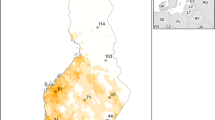Abstract
Watersheds of the US Geological Survey's Hydrologic Benchmark Network program were used in estimating annual yield of total nitrogen and nitrogen fractions (ammonium, nitrate, dissolved organic N, particulate N) in relation to amount of runoff, elevation, and watershed area. Only watersheds minimally disturbed with respect to the nitrogen cycle were used in the analysis (mostly natural vegetation cover, no point sources of N, atmospheric deposition of inorganic N < 10 kg ha−1 y−1). Statistical analysis of the yields of total nitrogen and nitrogen fractions showed that elevation and watershed area bear no significant relationship to nitrogen yield for these watersheds. The yields of total nitrogen and nitrogen fractions are, however, strongly related to runoff (r 2 = 0.91 for total N). Annual yield increases as runoff increases, but at a rate lower than runoff; annual discharge-weighted mean concentrations decline as annual runoff increases. Yields of total nitrogen and most nitrogen fractions bear a relationship to runoff that is nearly indistinguishable from a relationship that was documented previously for minimally disturbed watersheds of the American tropics. Overall, the results suggest strong interlatitudinal convergence of yields and percent fractionation for nitrogen in relation to runoff.
Similar content being viewed by others
References
Aber JD, Nadelhoffer KJ, Streudler P & Melillo J (1989) Nitrogen saturation in northern forest ecosystems. Bioscience 39: 378–386
Alexander RB, Slack JR, Ludtke AS, Fitzgerald KK & Schertz TL (1996) Data from selected U.S. Geological Survey National StreamWater QualityMonitoring Networks (WQN). US Geological Survey Digital Data Series, DDS-37
Alexander RB, Slack JR, Ludtke AS, Fitzgerald KK & Schertz TL (1998) Data from selected US Geological Survey National Stream Water Quality Monitoring Networks. Water Resources Research 34: 2401–2405
Dise NB & Wright RF (1995) Nitrogen leaching from European forests in relation to nitrogen deposition. Forest Ecology Management 71: 153–161
Howarth RW, Billen G, Swaney D, Townsend A, Jaworski M, Lajtha K, Downing JA, Elmgren R, Caraco N, Jordan T, Berendse F, Freney J, Kudeyarov V, Murdoch P & Ahao Liang S (1996) Regional nitrogen budgets and riverine N & P fluxes for the drainages to the North Atlantic Ocean: Natural and human influences. Biogeochemistry 38: 1–96
Lewis WM Jr, Melack JM, McDowell WH, McClain M & Richey JE (1999) Nitrogen yields from undisturbed watersheds in the Americas. Biogeochemistry 46: 149–162
Meybeck M (1982) Carbon, nitrogen, and phosphorus transport by world rivers. American Journal of Science 282: 401–450
Schertz TL, Wells FC & Ohe DJ (1994) Sources of trends in water quality data for selected streams in Texas, 1975-1989 water years. U.S. Geological Survey Water Resources Investigation Report 94-4213
Sickman JO & Melack JM (2002) Regional analysis of inorganic nitrogen yield and retention in high-elevation ecosystems of the Sierra Nevada and Rocky Mountains. Biogeochemistry 57/58: 341–374
Williams MR & Melack JM (1997) Atmospheric deposition, mass balances and processes regulating streamwater solute concentrations in mixed conifer catchments of the Sierra Nevada, California. Biogeochemistry 37: 111–144
Author information
Authors and Affiliations
Rights and permissions
About this article
Cite this article
Lewis, W.M. Yield of nitrogen from minimally disturbed watersheds of the United States. Biogeochemistry 57, 375–385 (2002). https://doi.org/10.1023/A:1015709128245
Issue Date:
DOI: https://doi.org/10.1023/A:1015709128245




